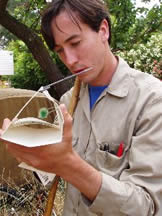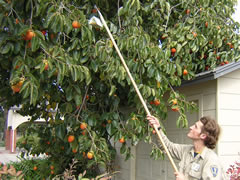Pest Detection
Guava Fruit Fly

Trapper inspecting a
Jackson Trap baited
with with methyl eugenol.

Fruit fly detection trap
placed in a Persimmon tree
Common Name: Guava Fruit Fly
Scientific Name:Bactrocera Correcta (Bezzi)
Pest Rating: "A"
DESCRIPTION
Bactrocera correcta is a brightly-colored brown and yellow fly approximately 6.0 millimeters (mm) in length. The wings are clear with a light brown band along the leading edge and a spot at the tip. The band along the leading edge has a clear gap before the wing tip. The top of the body of both sexes are entirely yellow and the legs mostly yellow. The face has a nearly continuous black band below the antennae. The ovipositor of the female is red and rather short, measuring approximately 3.0 mm when fully extended. Immature stages of B. correcta have not been described in the literature.
HISTORY AND ECONOMIC IMPORTANCE
This fruit fly is strongly attracted to methyl eugenol and is detected in Oriental fruit fly detection traps baited with methyl eugenol. B. correcta has the potential to become a major pest of citrus, peach, and several kinds of tropical and subtropical fruit hosts.
DISTRIBUTION
B. correcta occurs in India, Pakistan, Nepal, Sri Lanka, and Thailand and China. This pest has been detected numerous times in California since 1986. Through detection and eradication programs we have been able to keep it from becoming established.
ALAMEDA COUNTY PEST DETECTION
Guava fruit fly, Bactrocera correcta (Bezzi), has been captured in fruit fly detection traps in Alameda County three times since November, 1987. Most recently, on September 10, 2004, one male guava fruit fly was captured in a Jackson trap in Pleasanton; on August 23, 2000, one male fly was captured in a Jackson trap in Fremont; and on November 06, 1987, one male fly was captured in a Jackson trap in San Leandro.
LIFE CYCLE
There is no developmental information on B. correcta, but it is probably similar to B. zonata and B. tuberculatus, feeding on the same fruits.
HOSTS AND DAMAMGE
Recorded hosts include Citrus spp., Coffea canephora, Eugenia uniflora, mango, peach, apricot, guava, castor bean, castor-oil-plant, roseapple, jujube, Chinese date, fig, and sapodilla. Hosts of B. zonata must be considered potential hosts for B. correcta.
YOU CAN HELP
Working together we can keep these pests from becoming established in Alameda County. You can help by allowing Agriculture employees access to your property to install and monitor insect survey traps. To learn more, select the link below:
Pest Detection Survey

 Community Development Agency
Community Development Agency AGRICULTURE PROGRAMS
AGRICULTURE PROGRAMS

